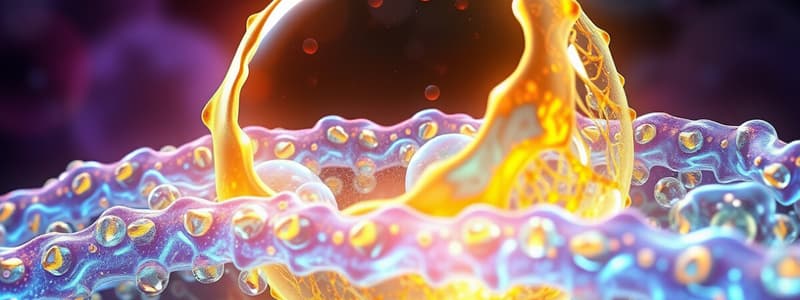Podcast
Questions and Answers
What are the two different types of cells?
What are the two different types of cells?
- Prokaryotic
- Neither A nor B
- Eukaryotic
- Both A and B (correct)
What is the plasma membrane?
What is the plasma membrane?
A selective barrier that all cells contain.
Why do organisms generally have many cells, not smaller cells?
Why do organisms generally have many cells, not smaller cells?
Cells increase in volume more than area, causing them to split before they get too large.
What is the fluid inside a cell?
What is the fluid inside a cell?
What are chromosomes?
What are chromosomes?
What are ribosomes?
What are ribosomes?
What are some differences between prokaryotic and eukaryotic cells?
What are some differences between prokaryotic and eukaryotic cells?
What do prokaryotes have?
What do prokaryotes have?
What is the nucleoid?
What is the nucleoid?
What are some differences between an animal cell and a plant cell?
What are some differences between an animal cell and a plant cell?
Cell membrane is also known as?
Cell membrane is also known as?
What are membranes usually made of?
What are membranes usually made of?
What is the primary purpose of a cell membrane?
What is the primary purpose of a cell membrane?
Which organelle has a single layer?
Which organelle has a single layer?
What does a pore complex do in the nucleus?
What does a pore complex do in the nucleus?
Where else are genes located aside from the nucleus and why?
Where else are genes located aside from the nucleus and why?
What is the nuclear lamina?
What is the nuclear lamina?
What is the nuclear matrix?
What is the nuclear matrix?
DNA is located in?
DNA is located in?
What is the nucleolus?
What is the nucleolus?
What are ribosomes made of?
What are ribosomes made of?
What are the two types of ribosomes?
What are the two types of ribosomes?
What are free ribosomes?
What are free ribosomes?
What are bound ribosomes?
What are bound ribosomes?
Cells that specialize in protein secretion have a high proportion of what?
Cells that specialize in protein secretion have a high proportion of what?
Flashcards are hidden until you start studying
Study Notes
Cell Types
- Two main types of cells: eukaryotic (complex, with nucleus and organelles) and prokaryotic (simpler, smaller, without nucleus).
Plasma Membrane
- All cells possess a plasma membrane that acts as a selective barrier for small, non-polar, uncharged substances.
- As a cell grows, its volume increases disproportionately to its surface area, prompting division before it becomes too large.
Importance of Multicellularity
- Organisms typically consist of multiple cells because increased volume necessitates cell division to maintain efficient function.
Cell Interior
- The fluid within cells is known as cytosol or cytoplasm.
Chromosomes and Genes
- Chromosomes carry genetic information encoded in DNA.
Ribosomes
- Ribosomes function as organelles responsible for protein synthesis.
Prokaryotic vs. Eukaryotic Cells
- Prokaryotic cells lack a nucleus, while eukaryotic cells have one, making them more complex.
- Eukaryotic cells generally contain membrane-bound organelles, which prokaryotes lack.
- Size difference: eukaryotic cells are typically larger.
- Prokaryotic cells may have flagella or fimbriae, while eukaryotic cells do not.
Prokaryotic Cell Structures
- Prokaryotes have structures such as:
- Fimbrae for surface movement
- Nucleoid region for unbound DNA
- Ribosomes for protein synthesis
- Plasma membrane, cell wall/capsule, flagella for movement.
Nucleoid
- In prokaryotes, the nucleoid contains the cell's DNA but is not a membrane-bound compartment.
Animal vs. Plant Cells
- Animal cells have centrioles, lysosomes, and extracellular matrix (ECM).
- Plant cells have central vacuoles, chloroplasts, amyloplasts, cell walls, chlorophyll, and can perform photosynthesis.
Cell Membrane Composition
- Also known as plasma membrane, it is primarily composed of a phospholipid bilayer, cholesterol, and proteins.
Function of Cell Membrane
- The primary role is to regulate the movement of substances in and out of the cell, maintaining a distinct internal environment.
Organelles with Single Membranes
- Lysosomes and peroxisomes (not part of the endomembrane system) have a single lipid bilayer.
Nucleus Structure and Function
- The nucleus is part of the endomembrane system and houses the majority of the cell’s genetic material within a double membrane.
- Pores allow for the transport of mRNA and proteins, regulated by pore complexes.
Gene Locations
- Genes are also found in mitochondria and chloroplasts, suggesting evolutionary origins as independent organisms captured by eukaryotic cells.
Nuclear Lamina
- This consists of a net-like arrangement of protein filaments that supports the nuclear shape.
Nuclear Matrix
- The nuclear matrix is a network of fibers that extends throughout the nucleus, providing structural support.
Chromatin
- DNA exists in the form of chromatin, a combination of DNA and proteins, found within chromosomes.
Nucleolus
- The nucleolus synthesizes ribosomal RNA (rRNA), crucial for forming ribosomal subunits, and may have multiple instances within a nucleus.
Ribosome Composition
- Ribosomes are made of rRNA and proteins, involved in synthesizing proteins by linking amino acids as per mRNA instructions.
Ribosome Types
- There are two types of ribosomes: free (in cytosol, functioning locally) and bound (attached to the endoplasmic reticulum, producing proteins for export).
Specialization in Protein Secretion
- Cells specialized for protein secretion typically have a higher proportion of bound ribosomes, facilitating the production of proteins for membranes or organelles.
Studying That Suits You
Use AI to generate personalized quizzes and flashcards to suit your learning preferences.




